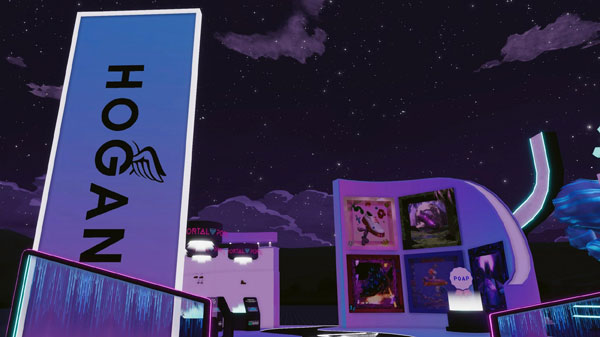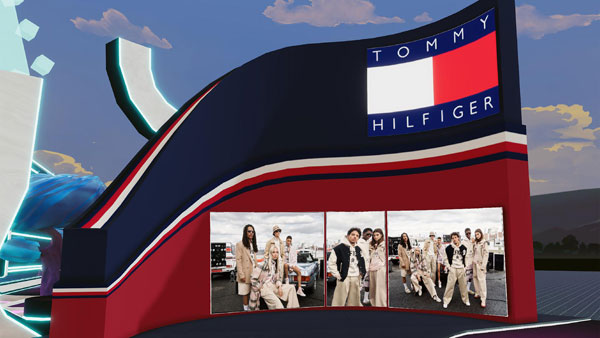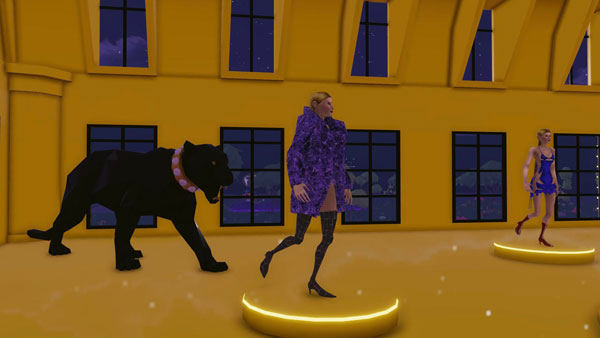
Metaverse Fashion Week: From Store Openings To Exclusive NFT Drops
Decentraland’s highly-anticipated Metaverse Fashion Week (MVFW) has come to a close and with it the fashion world has had its first taste of what the industry could look like through a fully digital experience. Running over the course of four days, from March 24 to 27, MVFW boasted a hefty schedule consisting of over 60 designers, brands and retailers looking to get in on the virtual action.
Among the events, which were all completely free to attend, a number of afterparties, masses of store openings and a series of digital collections were available for viewing on the digital platform. Special areas dedicated specifically to brand partners or the fashion industry as a whole were also launched in the 3D world, a possible nod to Decentraland’s intention to continue building on fashion’s place in its virtual world.
[caption id="attachment_24014" align="alignnone" width="600"] Hogan's Decentraland pop-up store at Metaverse Fashion Week.[/caption]
Store openings, digital retail and meta malls
Brands took advantage of the event to debut digital stores and pop-ups in various districts in Decentraland. The expansive range of purpose-built store spaces each displayed an assortment of brands’ phygital collections, exclusive non-fungible token (NFT) drops and branded activations that brought the user into their world. Many of these stores allowed their visitors to purchase both digital and physical items and NFTs from their offering, linking directly to the platform’s own cryptocurrency through digital wallets.
Luxury retailer Selfridges unveiled a flagship store complete with an immersive experience by Paco Rabanne and Victor Vasarely. The location itself, which resembled Selfridges’ Birmingham store, contained an art gallery of exclusive NFTs that visitors can view through a guided tour of the building.
[caption id="attachment_24015" align="alignnone" width="600"]
Hogan's Decentraland pop-up store at Metaverse Fashion Week.[/caption]
Store openings, digital retail and meta malls
Brands took advantage of the event to debut digital stores and pop-ups in various districts in Decentraland. The expansive range of purpose-built store spaces each displayed an assortment of brands’ phygital collections, exclusive non-fungible token (NFT) drops and branded activations that brought the user into their world. Many of these stores allowed their visitors to purchase both digital and physical items and NFTs from their offering, linking directly to the platform’s own cryptocurrency through digital wallets.
Luxury retailer Selfridges unveiled a flagship store complete with an immersive experience by Paco Rabanne and Victor Vasarely. The location itself, which resembled Selfridges’ Birmingham store, contained an art gallery of exclusive NFTs that visitors can view through a guided tour of the building.
[caption id="attachment_24015" align="alignnone" width="600"] Tommy Hilfiger store at Metaverse Fashion Week.[/caption]
Threedium and Boson Protocol also teamed up to open a digital mall during MVFW, besides DKNY and Casablanca. Tommy Hilfiger was among the store opening schedule at the location, offering up a digital remake of its spring 2022 collection as well as purchasable NFTs. Meanwhile, in Decentraland’s Luxury Fashion District, created in partnership with UNXD, Dolce & Gabbana, Etro and Franck Muller also got involved in the store opening frenzy, each debuting locations along the digital street, which drew inspiration from Paris’ Avenue Montaigne.
Another district that boasted big-name brands was Rarible’s Fresh Drip Zone, where, along the New York-like streets, visitors could find pop-ups of 12 brands, including Puma, Perry Ellis and Fred Segal. Digital fashion houses The Fabricant, who also hosted a runway show, and Placebo were additionally present, offering virtual wearables and NFTs for the sportswear brand enthusiasts. At the helm of the temporary location was a dome-shaped Rarible store at which users could purchase one-off NFTs and a curated selection of unique digital garments.
Industry presentations, panels and parties
Special panel discussions took place throughout the event, covering everything from the world of NFTs to the history of virtual fashion. In total, over 30 guests were present according to David Cash, the curator of MVFW and CEO of Cash Labs, the web3 strategy agency that aided in the event’s development. Speakers, presented by Cash Labs on MVFW’s MainStage, included the likes of fashion photographer Nick Knight, editor in chief of Vogue Singapore Norman Tan and fashion/furniture designer Alexandre de Betak.
[caption id="attachment_24016" align="alignnone" width="600"]
Tommy Hilfiger store at Metaverse Fashion Week.[/caption]
Threedium and Boson Protocol also teamed up to open a digital mall during MVFW, besides DKNY and Casablanca. Tommy Hilfiger was among the store opening schedule at the location, offering up a digital remake of its spring 2022 collection as well as purchasable NFTs. Meanwhile, in Decentraland’s Luxury Fashion District, created in partnership with UNXD, Dolce & Gabbana, Etro and Franck Muller also got involved in the store opening frenzy, each debuting locations along the digital street, which drew inspiration from Paris’ Avenue Montaigne.
Another district that boasted big-name brands was Rarible’s Fresh Drip Zone, where, along the New York-like streets, visitors could find pop-ups of 12 brands, including Puma, Perry Ellis and Fred Segal. Digital fashion houses The Fabricant, who also hosted a runway show, and Placebo were additionally present, offering virtual wearables and NFTs for the sportswear brand enthusiasts. At the helm of the temporary location was a dome-shaped Rarible store at which users could purchase one-off NFTs and a curated selection of unique digital garments.
Industry presentations, panels and parties
Special panel discussions took place throughout the event, covering everything from the world of NFTs to the history of virtual fashion. In total, over 30 guests were present according to David Cash, the curator of MVFW and CEO of Cash Labs, the web3 strategy agency that aided in the event’s development. Speakers, presented by Cash Labs on MVFW’s MainStage, included the likes of fashion photographer Nick Knight, editor in chief of Vogue Singapore Norman Tan and fashion/furniture designer Alexandre de Betak.
[caption id="attachment_24016" align="alignnone" width="600"] Dundas World store interior at Metaverse Fashion Week in Decentraland.[/caption]
A handful of luxury brands took to the stage in a string of runway shows displaying looks often inspired by their physical collections. Among them, Italian luxury brand Dolce & Gabbana debuted a digital collection of logo-heavy looks exhibited on feline-like models. Dundas closed the event’s runway line up with a showcase of digital dresses at its pop-up in the Luxury Fashion District. Bespoke items created specifically for MVFW shown at the event were available for pre-order via UNXD’s marketplace and were displayed among a branded store interior complete with Dundas’ signature black panther emblem. A screen in the store allowed visitors to also watch a real life version of models wearing the clothing.
Afterparties, virtual performances
Afterparties and virtual performances played an important role in bringing a selection of real-world experiences to the metaverse. Parties hosted by singers such as Tribute Band and Nicki Nicole were scattered throughout MVFW’s evening schedule, each hosted by either Kollectiff or other Decentraland partners. For its finale, singer-songwriter Claire Boucher, professionally known as Grimes, took to the virtual stage with a DJ set for the event’s guests. The performance could be viewed on a winding staircase that concluded with an avatar of the artist dressed in an Auroboros bodysuit dancing on a suspended platform.
What makes the virtual world so appealing?
The appeal is based on the simple fact that the metaverse allows its users another opportunity for self-expression and a creative outlet, which is not determined by physical laws or limitations, to put it simply, everything is possible within this digital space. The appeal isn’t solely based on its current novelty factors, as studies have already shown that people are likely to spend more time in virtual environments rather than on traditional websites, with some estimates going as far as predicting that one third of Gen Z customers will do their shopping through VR by 2025 and Morgan Stanley predicting that metaverse could constitute up to 10% of the luxury market by 2030. Fashion brands and beauty brands are amongst the early adopters of these new technologies, maybe in response to the industry’s initially relatively slow adaptation to e-commerce and social media, with each of the two now having become integral parts of each brand.
What is ‘Digital Fashion’?
As the metaverse is still relatively young, the concise definition of digital fashion has not yet been determined. Yes, one could understand it as purely digital garments which are later edited onto an existing image or used to dress an avatar, but digital fashion does not always have to be consumer-focused, it could also constitute the digitalization of certain internal processes of traditional garment production. More and more fashion schools are emphasizing the importance of new and digital 3D design tools, and also big brands have started to implement these into their production processes. Tommy Hilfiger is currently undergoing a change to a 100% digital design strategy, meaning that all of the design will be done in a digital manner, which is already showing very positive results, such as the reduction of the brand’s internal review process being shortened by two weeks. Additionally, these digital pieces look so realistic, that you can sometimes see them on their website without even noticing it.
Once a brand has created these digital assets, they can be used in multiple ways, the most prevalent right now being Extended Reality, which refers to augmented, mixed and virtual reality, making digital enhancements to our physical environment. Most of us have already experienced this through social media or on e-commerce websites that allow people to try on smaller pieces, like accessories or makeup. To achieve this for a full look is a bit more complicated, but progress is being made, as shown by Prada using this technology to try on purses, Gucci utilising it for AR try-ons of sneakers and Farfetch letting their customers try on puffer coats from Off-White digitally.
But besides all the great innovations that the metaverse might bring with it, there are also still a lot of issues to be figured out, especially when it comes to the legal framework in which digital goods are handled and sold, despite the ever growing demand. In the broader context this also brings up questions about personal data, especially in regards to possible future implementations of body scans for made-to-measure garments, who owns this data and who is granted access to this incredibly sensible data, as well as questions about the sale of digital garments still being heavily linked to the use of cryptocurrencies, whose value are determined by the demand.
Nevertheless, it has become clear that the transition into this digital space will constitute the future, especially as the next generation of customers Gen Z and its zeitgeist who are openly adopting this technology, forcing brands to adapt in order to not lose touch with the future driving force of the consumer base.
Dundas World store interior at Metaverse Fashion Week in Decentraland.[/caption]
A handful of luxury brands took to the stage in a string of runway shows displaying looks often inspired by their physical collections. Among them, Italian luxury brand Dolce & Gabbana debuted a digital collection of logo-heavy looks exhibited on feline-like models. Dundas closed the event’s runway line up with a showcase of digital dresses at its pop-up in the Luxury Fashion District. Bespoke items created specifically for MVFW shown at the event were available for pre-order via UNXD’s marketplace and were displayed among a branded store interior complete with Dundas’ signature black panther emblem. A screen in the store allowed visitors to also watch a real life version of models wearing the clothing.
Afterparties, virtual performances
Afterparties and virtual performances played an important role in bringing a selection of real-world experiences to the metaverse. Parties hosted by singers such as Tribute Band and Nicki Nicole were scattered throughout MVFW’s evening schedule, each hosted by either Kollectiff or other Decentraland partners. For its finale, singer-songwriter Claire Boucher, professionally known as Grimes, took to the virtual stage with a DJ set for the event’s guests. The performance could be viewed on a winding staircase that concluded with an avatar of the artist dressed in an Auroboros bodysuit dancing on a suspended platform.
What makes the virtual world so appealing?
The appeal is based on the simple fact that the metaverse allows its users another opportunity for self-expression and a creative outlet, which is not determined by physical laws or limitations, to put it simply, everything is possible within this digital space. The appeal isn’t solely based on its current novelty factors, as studies have already shown that people are likely to spend more time in virtual environments rather than on traditional websites, with some estimates going as far as predicting that one third of Gen Z customers will do their shopping through VR by 2025 and Morgan Stanley predicting that metaverse could constitute up to 10% of the luxury market by 2030. Fashion brands and beauty brands are amongst the early adopters of these new technologies, maybe in response to the industry’s initially relatively slow adaptation to e-commerce and social media, with each of the two now having become integral parts of each brand.
What is ‘Digital Fashion’?
As the metaverse is still relatively young, the concise definition of digital fashion has not yet been determined. Yes, one could understand it as purely digital garments which are later edited onto an existing image or used to dress an avatar, but digital fashion does not always have to be consumer-focused, it could also constitute the digitalization of certain internal processes of traditional garment production. More and more fashion schools are emphasizing the importance of new and digital 3D design tools, and also big brands have started to implement these into their production processes. Tommy Hilfiger is currently undergoing a change to a 100% digital design strategy, meaning that all of the design will be done in a digital manner, which is already showing very positive results, such as the reduction of the brand’s internal review process being shortened by two weeks. Additionally, these digital pieces look so realistic, that you can sometimes see them on their website without even noticing it.
Once a brand has created these digital assets, they can be used in multiple ways, the most prevalent right now being Extended Reality, which refers to augmented, mixed and virtual reality, making digital enhancements to our physical environment. Most of us have already experienced this through social media or on e-commerce websites that allow people to try on smaller pieces, like accessories or makeup. To achieve this for a full look is a bit more complicated, but progress is being made, as shown by Prada using this technology to try on purses, Gucci utilising it for AR try-ons of sneakers and Farfetch letting their customers try on puffer coats from Off-White digitally.
But besides all the great innovations that the metaverse might bring with it, there are also still a lot of issues to be figured out, especially when it comes to the legal framework in which digital goods are handled and sold, despite the ever growing demand. In the broader context this also brings up questions about personal data, especially in regards to possible future implementations of body scans for made-to-measure garments, who owns this data and who is granted access to this incredibly sensible data, as well as questions about the sale of digital garments still being heavily linked to the use of cryptocurrencies, whose value are determined by the demand.
Nevertheless, it has become clear that the transition into this digital space will constitute the future, especially as the next generation of customers Gen Z and its zeitgeist who are openly adopting this technology, forcing brands to adapt in order to not lose touch with the future driving force of the consumer base.

Textile Excellence
If you wish to Subscribe to Textile Excellence Print Edition, kindly fill in the below form and we shall get back to you with details.








